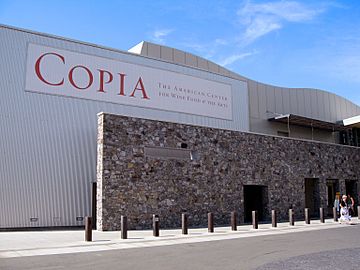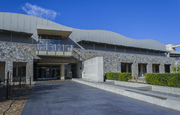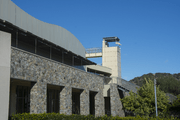Copia (museum) facts for kids
 |
|
| Lua error in Module:Location_map at line 420: attempt to index field 'wikibase' (a nil value). | |
| Established | November 18, 2001 |
|---|---|
| Dissolved | December 2008 |
| Location | 500 First Street, Napa, California 94559 |
| Type | Specialized |
Copia: The American Center for Wine, Food & the Arts was a special museum and learning center in downtown Napa, California. It was all about American culture, especially focusing on wine, food, and art. Famous winemakers Robert and Margrit Mondavi helped plan and pay for most of it.
Copia was open from 2001 to 2008. It had a big building with art galleries, two theaters, classrooms, and a kitchen for cooking demonstrations. There was also a restaurant, a library with rare books, and a large garden where vegetables and herbs grew. Copia hosted many events, like wine and food tastings, art shows, movies, and concerts. Its main exhibit, "Forks in the Road," showed how cooking changed from ancient times to today. Copia's opening helped the city of Napa grow and improve its downtown area.
The center opened on November 18, 2001. Famous chef Julia Child also helped fund it, and a restaurant called Julia's Kitchen was named after her. However, Copia didn't get as many visitors as expected and struggled to pay its bills. Even with money from tickets, memberships, and donations, it wasn't enough. After trying many changes to earn more money, Copia closed on November 21, 2008. Its library was given to Napa Valley College, and Julia Child's cooking tools went to the National Museum of American History. The property was later bought by the Culinary Institute of America, which opened a new campus there called the Culinary Institute of America at Copia.
Contents
Copia's Story: From Opening to Closing
How Copia Got Its Name
The museum was first called the American Center for Wine, Food and the Arts. But before it opened, it was also named Copia. Copia is the name of a Roman goddess who represents wealth and plenty. She was sometimes called Bona Copia in old poems.
Why Napa Needed Copia
The city of Napa didn't get as many tourists as other wine country towns nearby. To help the city grow, a big project was done to widen the Napa River and build new bridges. This led to new buildings, hotels, and places like Copia and the Oxbow Public Market. These projects aimed to bring more tourists and attention to downtown Napa.
Copia opened in 2001, just two months after the September 11 attacks. The museum believed that fewer tourists came because of the attacks, which made it harder for them to get enough visitors.
Building Copia: The Beginning
The Land Where Copia Stood
For many years, from the late 1800s to the 1990s, the land where Copia was built used to be a large garden called the Rossi-Massa-Vallerga Garden. This area was once part of a big land grant when California was a Mexican province. The site had several old Italian-style buildings and a garden.
Two cousins from Italy, Giovanni and Antonio Rossi, started a vegetable garden there around 1872. Later, another Italian immigrant, Giuseppe Vallerga, bought the land. He farmed it to supply his produce stand. After he passed away in 1957, his son built a grocery store on part of the land. The Vallerga family owned the property until the 1990s.
In 1996, a city group said the garden site was very important for Napa's history. They noted it showed the strong Italian presence in the area and how Italian farming influenced the city's growth.
Making the Museum a Reality
In 1988, winemaker Robert Mondavi, his wife Margrit Mondavi, and others in the wine industry wanted to create a place to celebrate American achievements in cooking, art, and winemaking. Several universities and food groups supported this idea.
In 1993, Robert Mondavi bought the land for Copia for $1.2 million and then gave a big gift of $20 million to start the project. His wife wanted the museum to be in downtown Napa. A famous architect named James Polshek was hired to design the building in 1994. Many other supporters also gave large donations. Before opening in 2001, Copia had about $55 million in initial funding and another $78 million from bonds.
Building Copia helped other new places appear in downtown Napa, like hotels, restaurants, and the Oxbow Public Market. Construction started in 1999, and Copia opened its doors on November 18, 2001.
Copia's Struggles and Closure
Even though Copia attracted some visitors, not enough local people came as often as hoped. The museum had expected 300,000 visitors each year, but it never reached that number.
In 2006, Copia announced it would change its art galleries into meeting rooms and focus less on art. It also had to let go of many employees. At this time, Copia owed about $68 million. The museum lowered its ticket price from $12.50 to $5. For three months, they even let people in for free, which helped increase visitors and income. Copia also started hosting weddings and renting out its spaces more often to earn money. In 2007, the museum changed its focus again, concentrating only on wine, not food or art. They even replaced some gardens with vineyards.
In September 2008, the museum announced more employees would be laid off, and it would only be open three days a week instead of seven. Since it opened, Copia had always spent more money than it earned. In November, the museum announced it would have to sell the property because it couldn't pay its debts.
Copia closed suddenly on Friday, November 21, 2008. Visitors arriving for events found a notice saying it was temporarily closed. The museum later said it would reopen on December 1. But on that day, the organization, which owed about $80 million, filed for bankruptcy. This meant they couldn't pay their debts. A court stopped a special loan, leaving Copia with no money to reopen.
Newspapers like The New York Times suggested that Copia failed because it wasn't clear what it was. People weren't sure if it was a museum, a cooking school, or a place to promote wine.
What Happened After Copia Closed
After Copia closed in 2008, a group of people tried to save the building and grounds. They wanted to find a way to buy the property, but their plan didn't work out. Other developers, including the Culinary Institute of America, also showed interest in buying the property.
Copia's library, with about 1,000 cookbooks, was given to Napa Valley College. By 2010, local chefs had brought the center's garden back to life, and a weekly farmer's market started in the parking lot. In 2012, most of Copia's items, like furniture, equipment, wine, and art, were sold at an auction.
The building was used for a few events, like the Napa Valley Film Festival. In 2015, the Culinary Institute of America (CIA) bought the northern part of the property for $12.5 million. The CIA opened a new campus there, the Culinary Institute of America at Copia, which includes their new Food Business School. This new campus opened in late 2016. In 2017, the Chuck Williams Culinary Arts Museum opened there, displaying about 4,000 items from Chuck Williams, including cookbooks and cooking tools.
Copia's Cool Features
Copia was located on First Street in downtown Napa, right next to the Oxbow Public Market. The property was surrounded by a bend in the Napa River. The building was two stories tall and made mostly of polished concrete, metal, and glass. Since 2004, the city's farmer's market has been held in Copia's parking lot.
The museum had a large gallery space for art, history, and science exhibits. It also featured an indoor theater with 280 seats and an outdoor theater with 500 seats. There were classrooms, a kitchen for cooking demonstrations with 80 seats, and a special library with rare books. Visitors could also enjoy a wine-tasting area, a café called American Market Cafe, and a gift shop.
One of the most popular features was the 3.5-acre garden, filled with beautiful plants, vegetables, and herbs. The building was designed by Polshek Partnership Architects.
Julia's Kitchen
Inside Copia was a restaurant called Julia's Kitchen. It focused on fresh, seasonal food and was named after the famous chef Julia Child. She even loaned some of her own kitchen items to the restaurant, like a wall display of 49 pans, pots, and other tools. After Copia closed, these items were sent to the Smithsonian Institution's National Museum of American History, where they are part of the Julia Child's kitchen exhibit.
Julia's Kitchen had a dining room that could seat 180 people, plus outdoor seating. The gardens also had fruit trees, a special pavilion with a kitchen, and a small vineyard with 60 grapevines.
Exhibits and Events
Copia's main exhibit was called "Forks in the Road: Food, Wine and the American Table." It showed how cooking developed over time and included a big part about the history of winemaking in America. The first art show at Copia was called "Active Ingredients," featuring new art related to food.
Copia also hosted an annual event called "Canstruction" starting in 2005. Teams of architects and designers created amazing sculptures using cans of food. After the event, all the canned food was donated to the Napa Valley Food Bank. In the first year, they donated 42,000 pounds of food!
Who Ran Copia and How Many Visitors Came
Peggy Loar was the first director of Copia, leaving in 2005. Arthur Jacobus took over, and then Garry McGuire Jr. became director in 2008. The person in charge of wine programs, Peter Marks, was replaced by Andrea Robinson. Around 2008, celebrity chef Tyler Florence was hired to oversee the food programs and Julia's Kitchen.
Copia had hoped to get 300,000 visitors each year. For comparison, Napa County had 4.5 million tourists in 2001. Here's how many visitors Copia actually had:
- 2001: 205,000 visitors
- 2002: 220,000 visitors
- 2003: 160,000 visitors
- 2007: 150,000 visitors




